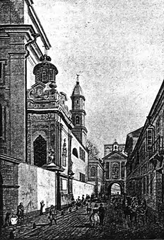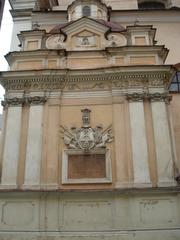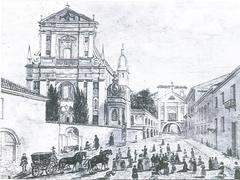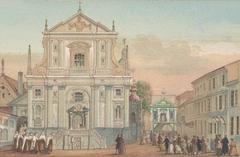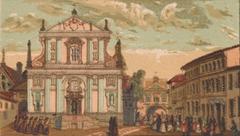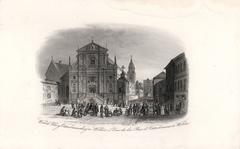
Church of St. Theresa, Vilnius: Visiting Hours, Tickets & Historical Insights
Date: 14/06/2025
Introduction
The Church of St. Theresa in Vilnius (Šv. Teresės bažnyčia) stands as a masterwork of Baroque architecture, a cornerstone of Catholic spiritual life, and an enduring symbol of Vilnius’s rich cultural tapestry. Nestled in the heart of Vilnius Old Town, adjacent to the iconic Gate of Dawn, St. Theresa’s is renowned for its ornate façade, Rococo interiors, and historical resilience. Whether you are a devotee, an architecture enthusiast, or a traveler exploring Vilnius historical sites, this guide provides all essential information—from visiting hours and ticketing to architecture and nearby attractions—to ensure a memorable and insightful experience (In Your Pocket; Walkable Vilnius; Nomad Epicureans; Vilnius Tourism).
Table of Contents
- Historical Background
- Architectural & Artistic Features
- The Monastery Complex and Urban Setting
- Cultural and Spiritual Significance
- Visiting Information
- Practical Tips for Visitors
- Nearby Attractions & Suggested Itineraries
- Frequently Asked Questions (FAQ)
- Visuals & Media Suggestions
- Conclusion
- References & Further Reading
Historical Background
Founding and Counter-Reformation Origins
The Church of St. Theresa was established during the flourishing of the Counter-Reformation in the Grand Duchy of Lithuania. The initiative came from Steponas Pacas, Deputy Chancellor of Lithuania, who commissioned the church for the Discalced Carmelites—a branch of the Carmelite order noted for their asceticism and mystical spirituality. Construction began in the 1630s and culminated in consecration in 1654 (In Your Pocket; Catholic Shrine Basilica). The church’s establishment marked a pivotal moment in Vilnius’s religious history, creating a lasting spiritual center and introducing Baroque innovation to the city’s skyline.
Architectural Development
Swiss-born architect Constantino Tencalla was the mastermind behind St. Theresa’s design, integrating Early Baroque forms with unique Carmelite influences. The church is notable for its towerless façade—an unusual feature among Baroque churches in Lithuania—offset by a distinctive four-phased belfry topped with an angelic weathervane (walkablevilnius.com; ldkistorija.lt). The interior saw significant transformation in the mid-18th century, with Rococo elements added by local artist Motiejus Sluščianskis, whose frescoes and illusionistic altars remain highlights of the church’s artistic program (Catholic Shrine Basilica).
Architectural & Artistic Features
Exterior and Façade
St. Theresa’s façade exemplifies Baroque grandeur while incorporating local adaptations. Its three-tiered composition draws inspiration from the Jesuit Church of the Gesù in Rome, but stands out for its lack of towers and its decorative obelisks and volutes (ldkistorija.lt). Materials such as marble, granite, and sandstone reflect the ambitions of its patrons (panoramas.lt). The four-phased belfry is crowned by an angel with a trumpet, a unique feature among Lithuanian churches (walkablevilnius.com). The arched portal, attributed to Italian architect Carpoforo Tencalla, is set within an elevated base necessitated by the church’s location near the city gate (architekturalietuvoje.lt).
Interior Decoration
The interior is celebrated for its immersive Rococo design, added between 1760–1764. Motiejus Sluščianskis’s frescoes depict scenes from the life of St. Theresa of Ávila, expressing the Carmelite emphasis on mystical union with God (cityofmercy.lt). The high altar features the renowned painting of the Ecstasy of St. Theresa, while side altars and stucco decorations add to the church’s visual richness. The feet of the wooden Christ figure on the main altar bear the mark of centuries of veneration (walkablevilnius.com). Stained glass windows and gilded details augment the contemplative atmosphere (evendo.com).
The Monastery Complex and Urban Setting
Originally, St. Theresa’s was the centerpiece of a vast Carmelite monastery complex, which encompassed three city blocks and was integrated into the city’s defensive walls. The ensemble included the Gate of Dawn, still home to the revered icon of Our Lady of Mercy (cityofmercy.lt). The church’s location at Aušros Vartų g. 14 places it at the heart of Vilnius Old Town, surrounded by historic streets, cafes, and other landmarks (evendo.com).
Cultural and Spiritual Significance
Pilgrimage and Festivals
St. Theresa’s Church is a vital spiritual center, closely linked to the Gate of Dawn—one of the region’s most important pilgrimage sites. Major religious events include the June 26th celebration of the transfer of relics and the November “Great Protection” festival. Pilgrims from across Lithuania and beyond visit for Mass, prayer, and reflection (My Global Viewpoint).
Resilience Through History
Throughout its history, the church has faced closures and restrictions during tsarist and Soviet rule (Codelt). Its survival and restoration in the 20th century symbolize the resilience of Lithuania’s Catholic community and cultural identity.
Visiting Information
Location
- Address: Aušros Vartų g. 14, Vilnius 01303, Lithuania—adjacent to the Gate of Dawn.
- Public Transport: Easily accessible by city buses and trolleybuses. Paid parking is available nearby, though limited.
Opening Hours & Tickets
- Visiting Hours: The church is generally open daily from 7:00 AM to 7:00 PM. Hours may vary during religious holidays and special events (Nomad Epicureans; Triphobo).
- Tickets: Entry is free of charge. Donations for maintenance are appreciated.
Accessibility
- Wheelchair accessible via main entrance ramp.
- Assistance available upon request.
- Some areas may have steps or uneven flooring.
Guided Tours
- Available in English, Lithuanian, and Russian.
- Advance booking is recommended—contact the parish office or Vilnius tourism office for arrangements.
Practical Tips for Visitors
- Dress Code: Modest attire is required (shoulders/knees covered, hats removed inside).
- Photography: Non-flash photography is permitted; be discreet, especially during services.
- Facilities: No restrooms inside; public toilets are nearby in Old Town.
- Best Times to Visit: Early mornings or weekdays for a quieter experience. The church is busiest around 4 PM and during festivals (Triphobo).
Nearby Attractions & Suggested Itineraries
- Gate of Dawn (Aušros Vartai): Major pilgrimage site, adjacent to the church.
- Vilnius Old Town: UNESCO World Heritage Site with Gothic, Renaissance, and Baroque landmarks.
- University of Vilnius, Town Hall Square, Church of St. Casimir: All within walking distance.
- Other Sites: Choral Synagogue, Bernardine Church, St. Anne’s Church (Toosquaretobehip).
Frequently Asked Questions (FAQ)
Q: What are the visiting hours of St. Theresa Church Vilnius?
A: Daily from 7:00 AM to 7:00 PM; verify locally for holiday adjustments.
Q: Is there an entrance fee?
A: Admission is free; donations are welcome.
Q: Are guided tours available?
A: Yes, in several languages; book in advance through the parish or tourism office.
Q: Is the church accessible for visitors with disabilities?
A: Yes, with wheelchair access and some assistance available.
Q: Is photography allowed?
A: Yes, non-flash photography is permitted, respectfully.
Q: Are there special events at the church?
A: Yes, especially during Marian feasts and city festivals; see event calendars.
Visuals & Media Suggestions
- Photography: Capture the Baroque façade, Rococo altars, frescoes, and the unique angelic belfry.
- Alt Tags for SEO: “Church of St. Theresa Vilnius Baroque façade,” “St. Theresa Church Rococo interior,” “Vilnius historical sites.”
- Virtual Tours: Explore available galleries on Vilnius tourism sites for a preview of the church’s splendor.
Conclusion
The Church of St. Theresa in Vilnius is a must-see for anyone seeking to engage with the city’s spiritual heritage, architectural beauty, and living history. Its free entry, central location, and welcoming atmosphere make it accessible to all. For an even richer experience, plan your visit around religious festivals or join a guided tour to delve deeper into the church’s history and artistry.
For the latest updates on visiting hours, events, and tours, consult the Vilnius tourism portal or download the Audiala app. Stay connected for more insights into Vilnius historical sites and cultural events.
References & Further Reading
- In Your Pocket
- Walkable Vilnius
- Nomad Epicureans
- Triphobo
- Catholic Shrine Basilica
- City of Mercy
- Vilnius with Locals
- Toosquaretobehip
- My Global Viewpoint
- Codelt
- architekturalietuvoje.lt
- ldkistorija.lt
- panoramas.lt
- evendo.com


